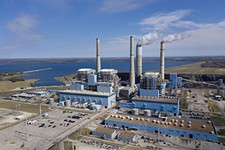Cool Cities: AE Task Force
Juggling the Energy Scenarios
By Nora Ankrum, Fri., Nov. 13, 2009

For the last four months, nine representatives of local consumer, environmental, commercial, and industrial groups have been meeting once a week at City Hall to talk about "the future of Austin Energy" – more specifically, what magical mix of renewable power the utility ought to establish over the next decade both to meet the criteria of the Austin Climate Protection Plan and to provide reliable, affordable electricity to ratepayers. Known collectively as the Austin Generation Resource Planning Task Force, the council-appointed members spent their Wednesday afternoons scrutinizing the financial and environmental implications of various combinations of solar, wind, biomass, coal, natural gas, and nuclear power. Then, last week, they took a vote – or two or four.
Tasked with making one recommendation to council, in the end the group actually made several. The members voted unanimously not on a specific generation portfolio but on a set of guidelines for Austin Energy to follow (see "Energy Mix Highlights," below). Then three members – those from the commercial/industrial bloc – voted to support a resource mix they'd developed themselves, dubbed Task Force Scenario No. 2, that attempts to achieve cost savings through greater emphasis on "distributed generation," like rooftop solar and similar initiatives. Energy consultant Mike Sloan cast the lone vote for Scenario No. 1, a plan that would completely ramp down the Fayette coal plant by 2014. The remaining five members provided the majority vote to support the (unnumbered) generation mix AE had recommended in August, but with a proviso that AE "review the plan in two years with the target of accelerating the phase down of Fayette plant and toward its eventual closure by 2020 if economically and technologically feasible."
Because the coal-burning Fayette Power Project accounts for 71% of the utility's carbon-dioxide emissions, it has become a major sticking point in the generation-plan debate. "The nation and the world watches Austin," said former ACPP Program Manager Jake Stewart, who visited the task force before the vote to argue against the Fayette plant. "If we can't get out of coal in 10 years," he said, "it puts us in a precarious situation as a nation and as a planet." Though AE's proposal exceeds the environmental goals set by the ACPP, it does not close Fayette. It does propose "setting the stage for eventual sale or other disposition of Austin's share" – but that wasn't enough for the task force majority.
Coal hasn't been the group's only sticking point; cost has also been an issue. AE hired Pace Consulting to spin a dazzling array of cost and risk analyses for several scenarios. But with the exception of a scenario adding nuclear power, the data – including AE's plan and a scenario that replaces the Fayette Power Project with renewables – showed "a pretty narrow range of economic outcomes," as Solar Austin's Cary Ferchill put it. Other task force members agreed. "Everything I've seen shows that there is just not that much difference in the pricing," said member Chris Herbert, who also chairs the Resource Management Commission. Members Ferchill, Sloan, the Sierra Club's Cyrus Reed, and Public Citizen's Matt Johnson have been particularly enthusiastic about data showing that phasing out Fayette by 2020 costs only a few dollars more per megawatt than AE's plan.
Narrow as that difference is, it still poses potential difficulties for two groups: the lowest-income customers, from whose budgets a couple of dollars means a big bite, and the highest-income – businesses that use the most electricity – for whom small differences quickly accumulate. Without the purview to address rate issues (only City Council can decide "who pays for what," says AE General Manager Roger Duncan), the task force tackled the first issue the way AE does – with a push for special programs assisting low-income customers.
Satisfying the commercial/industrial interests proved trickier. In October, the Power Improvement Action Committee, a group that represents AE's largest users, called AE's plan "an unreasonable burden on [our] community at this time." The committee recommended various improvements, including "cost goals," a flexible planning process to allow for updates "based on changes to forecasts and assumptions," and increased demand-side management. The task force's guidelines reflect all of these priorities. Still, three members – the Building Owners and Managers Association's John Sutton, Spansion's Ron Rogerson, and Freescale's Roger Wood – voted for their own plan, Scenario No. 2, which they designed themselves to reduce capital outlay.
Still, Sutton says, "When you get down to it, the scenarios – there's not a whole lot of difference between them." He says he's comfortable with the task force's recommendations mainly because of the "triggers and double-checks" it has built into the process going forward. (Download the minority reports written by supporters of scenarios 1 and 2.)
The Electric Utility Commission and the Resource Management Commission expect to make their recommendations Nov. 16 and 17. AE will then take all three recommendations, along with its own, to City Council; no date has yet been set. As a matter of "process," says Duncan, AE will not be changing its own proposal based on those of the citizen groups. "We will stand up and say whether we agree or disagree with particular amendments and why," he said, "but it's up to the council to put together the final package."
Energy Mix Highlights
The Generation Resource Planning Task Force voted unanimously to recommend that any generation plan adopted by City Council be subject to the following guidelines (the group laid out specific strategies and goals for each of the guidelines, available in the full report ):
1) Increase conservation and efficiency.
2) Favor carbon-free generation over carbon-based resources, subject to economic feasibility.
3) Reassess the plan as new cost and environmental data become available.
4) Consider expanded natural gas facilities.
5) Consider nuclear power. (While the task force "does not recommend additional nuclear power at this time," it does recommend considering it "in the event power from nuclear or other generation sources is offered to Austin Energy.")
6) Reduce bill impact on those least able to pay.
7) Ensure maximum transparency and public participation in energy resource decisions (e.g., any decision to acquire 10 megawatts or more of capacity should be considered by all applicable commissions and presented twice to council before approval).
8) Assume leadership role in the Austin Climate Protection Plan.
9) Maintain the reliability and quality of the Austin Energy transmission and distribution system.
Got something to say on the subject? Send a letter to the editor.










